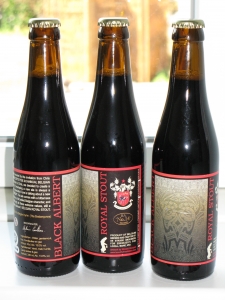Guinness Celebrates 250 Years
Once upon a time, there lived a man by the name of Arthur Guinness. Arthur dreamed of owning his very own brewery.

And in 1759, his dream became a reality with the signing of a 9,000-year lease at St. James’s Gate Brewery in Dublin. Ten years later, Guinness exported his ale for the first time (mostly to England). To this day, St. James remains the flagship brewery for Guinness.
In the beginning, Arthur mostly brewed ales. He decided to stop making ales and start making porters in 1779. The Guinness that we know today is based on the porter style that originated in London in the early 18th century.

Despite common folklore, Guinness did not invent the “stout” style. In fact, Guinness did not start using the stout label until the 1840′s. The first Guinness beers to use the term “stout” were the Single Stout and Double Stout. They had an original gravity of over 1.070. The contemporary Guinness Draught and Extra Stout are significantly weaker today.

Guinness stout is available in a number of variants and strengths. The most popular by far is the Guinness Draught. More than 1.8 billion pints of it are consumed in 150 countries each year.
In honor of the 250th anniversary of the signing of the lease for St. James’s Brewery, Guinness has released a special beer. The anniversary stout will be available only in the U.S., Australia and Singapore. The length of release is rumored to be 6 months, starting from the end of April.

Unlike the Guinness Draught, which uses a combination of nitrogen and carbon dioxide, Guinness 250th Anniversary Stout soley uses carbonation. The anniversary stout also contains more alcohol, weighing in around 5% (Guiness Draight is 4.2%).

Whereas Guinness is definitely not my favorite beer on the market, it is definitely a “go-to” beer when my only options consist of the Evil 3 corporate beers, imported lagers and Guinness. To me, Guinness is a really light beer. I laugh at all my friends who try to tell me Guinness is too rich for them. Put Guinness Draught up against De Struise Brouwers Black Albert and the Guinness will taste like water.

I am keeping my eyes and ears open for the arrival of the Guinness 250th Anniversary Stout in my local market … and I urge you all to do the same. Guinness is rich with history and deserves to be celebrated!
 CHEERS!!!
CHEERS!!!















Brew Hilda May 5th, 2009 at 2:56 pm
Mmm. Sounds like a winner. Thanks for the heads up!
(No pun intended)
Joel May 6th, 2009 at 5:33 pm
It took me some time, initially to convert to the “strong” taste of Guiness – like you, I now find it to be on the mild side. All things with time…
The one thing I find really intruiging by Guinness is the effect temperature has on it’s taste. Maybe it’s in my head but I’ve tested this theory on a lot of friends and the results are pretty universal – when it’s served cold (colder than most taps in North America), it becomes less bitter and more nutty. Very few pubs keep it cold enough (or warm enough if you are ultra traditional) and I’ve found that people who find it rich will actually find it much more “drinkable” when chilled further.
The UK has an EXTRA cold version which is essentially the same beer except they chill the lines all the way to the tap to keep it cold. THey also have a draft product called Guiness Red in some areas which is similar to Guiness with a bit of amber in it. Been too long to offer a taste profile though
Thanks for the blog, learned quite a bit,
Joel
Dana May 10th, 2009 at 7:44 pm
Got a 6 of the 250 year. It is very tasty. Much better than normal Guiness, which I already liked. Surprising how different it is.
Hussman May 24th, 2009 at 9:06 am
I’ve had the 250 Stout and it is delicious. Wife likes it as well, and she does not like Guinness draught.
Bill May 29th, 2009 at 3:05 pm
I found some 250 recently. It’s good, but nothing too spectacular to my taste buds. I prefer Guiness on draft.
This Week’s Headlines « Irish Fireside May 31st, 2009 at 8:00 am
[...] Guinness Celebrates 250 Years http://drinkwiththewench.com/2009/05/03/guinness-celebrates-250-years [...]
Scott-TheBrewCLub June 7th, 2009 at 11:04 am
I just found this 250 batch at one of my local places and so I picked it up. I haven’t tried it yet, but I’m very curious to taste the differences! Interesting how it isn’t going to be available to their domestic market? Wonder why.
Cheers!
Stuart Reb Donald September 18th, 2009 at 8:15 pm
Wench, you rock when others merely roll.